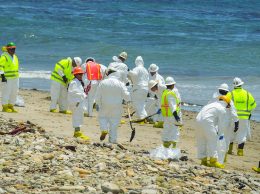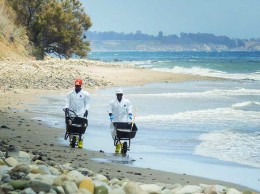Regulators put tri-county crab season on ice
IN THIS ARTICLE
- Latest news Topic
- pacbiztimes Author
By pacbiztimes Friday, November 6th, 2015
Regulators have put crab season on ice.
The tri-county commercial fishing industry is feeling the sting of a toxin that’s been found in some of the area’s seafood.
The California Department of Public Health advised consumers in a Nov. 3 announcement not to eat Dungeness and rock crabs caught between the Oregon border and the southern Santa Barbara County line because some contained dangerous levels of domoic acid.
The California Department of Fish and Wildlife has since indefinitely closed the Dungeness and rock crab fisheries in that region, according to Chris Voss, executive director of the Commercial Fishermen of Santa Barbara.
“It’s a disaster,” he said.
The toxin can cause intestinal issues in mild cases; rare severe cases can lead to death, fish and wildlife officials said. But there have been no related illnesses yet, they said.
This is one of the busiest times for fishermen as the holidays near.
Rick Gutierrez works for the Santa Barbara Seafood Station, which is losing about $10,000 a week.
“There are three or four other companies in Santa Barbara that do the same amount of business,” said Gutierrez, adding that they make about a third of their business this time of year.
But Santa Barbara fishermen contend that there haven’t been enough tests, especially throughout Santa Barbara where fisheries span miles of open water. Public health officials have mainly tested the viscera, or the gut, not the meat, Voss said.
“We should be very careful in how we declare these closures and be certain they are necessary,” said Voss, adding that the regulators haven’t been responsive to repeated phone calls. “We are all concerned about catching and selling safe seafood but we also want the agencies that are in charge of closures to make sure they make them with justification.”
The major buyers of Santa Barbara rock crab canceled all of their orders on Nov. 4, sources said. Smaller buyers followed suit shortly thereafter. Buyers are also asking for refunds of their current stock.
“Crab is an important part of California’s culture and economy, and I did not make this decision lightly,” Chuck Bonham, the fish and wildlife director, said in a Nov. 6 statement. “But doing everything we can to limit the risk to public health has to take precedence.”
Santa Barbara commercial fishermen generated more than $1.9 million in 2013 from the sale of rock crab, according to CFSB. Santa Barbara supplies about 75 percent of California’s rock crab; the vast majority is shipped outside of Santa Barbara for an average of $1.50 per pound.
The California Fish and Game Commission voted on Nov. 5 to postpone the recreational Dungeness season, as well as close recreational Dungeness and rock crab fisheries north of the Ventura County line. The commercial Dungeness crab season is slated to begin Nov. 15, while the recreational season was planned to start on Nov. 7. The commission closed the commercial rock crab season on Nov. 6.
“They have shown very little cause,” Gutierrez said.
The state Office of Environmental Health Hazard Assessment endorsed the delay and closures after tests by the Department of Public Health found high levels of the neurotoxin potentially brought on by algae blooms that proliferate with warmer water.
About half of six samples of Santa Barbara rock crab collected on Nov. 3 had toxin levels above the safety threshold in the viscera, according to the public health department. But the sample size wasn’t broad enough, Gutierrez said.
The safe levels, according to the department, are 20 parts per million in all fish and 30 parts per million in specifically the crab’s viscera.
“The rising water temperature is really concerning,” Gutierrez said.
Regional crab fishermen have already been hit by a six-week closure of fisheries near the Gaviota coast following May 19th’s Refugio oil spill. They are also facing competition from Mexican fishermen who have been selling their product for about half of Santa Barbara’s going rate, Gutierrez said.
The domoic acid scare has also hurt lobster sales, Voss said. The sales of California spiny lobster netted more than $3.3 million in 2013.
In the meantime, Santa Barbara commercial fishermen mull over potential legal action if the regulators aren’t transparent with their findings and the methods used. They may perform independent tests as well.
The department of public health and the office of environmental health hazards will continue to test crab along the coast. Once two consecutive tests seven days apart demonstrate safe toxin levels, the department of fish and wildlife can reopen the fisheries.
“It appears the most recent results from the Central Coast indicate that concentrations are declining,” Voss said.
But even after the crabs are deemed safe to eat, it may take some time for sales to rebound.
• Contact Alex Kacik at [email protected].












